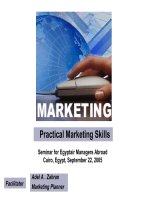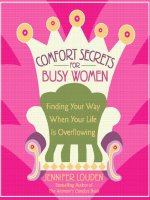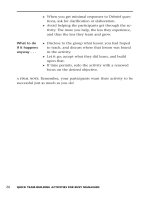Quick Team-Building Activities for Busy Managers: 50 Exercises That Get Results in Just 15 Minutes_2 pdf
Bạn đang xem bản rút gọn của tài liệu. Xem và tải ngay bản đầy đủ của tài liệu tại đây (206.73 KB, 19 trang )
CHAPTER 1
How to Run
a Successful
Team-Building
Activity
Step 1. Before: Select an activity that’s good for
your team.
The best team-building activity can become the worst team-building ex-
perience when there is no clear objective. Why spend the time, effort,
and money on an activity if you can’t identify the business reason or
team benefit you expect as a result? If all you want is to have some
fun and kill some time, play a parlor game and enjoy. But if you want
to improve your team’s effectiveness, you need to select an activity
that will give you your desired results!
Start with a clear objective in mind. What, specifically, do you want
your team to learn or accomplish? Think about it. Your goal should be:
➤ Attainable by your team.
➤ Relevant and applicable to where they are as a team right now.
➤ Something that will be reinforced long after this activity.
Plan on this activity being one of many small steps your team will
start taking now. Remember, an effective team is built primarily on
QUICK TEAM-BUILDING ACTIVITIES FOR BUSY MANAGERS 7
miller chap 01 7/24/03 3:33 PM Page 7
trust. Trust, and thus team-building, can rarely be accomplished in one
giant leap.
Match your goal to the activity in this book that will best help you get
the results you want. If there is more than one good match, do one
activity now and another one at a later date.
A NOTE ON COMPETITION: Competition can be a good thing. It can excite,
energize, and challenge people to participate better. Do not assume
that competition naturally brings out the best in everyone, though. It
can also deflate, discourage, and create unnecessary lingering conflict.
As the final judge in competitive activities, you risk becoming “the
bad guy” as well. So only you can say how competitive you want your
team-building activity to be. The most important thing is to be delib-
erate in your decision, so you can justify it with a clear objective if
necessary. Consider:
➤ The current level of competition within the team.
➤ The emotional health of the participants in dealing with defeat.
➤ How intimidating or intimidated the participants are.
➤ Your ability to diffuse real conflict among the team members.
Step 2. Before: Prepare for your team-building activity.
You want to make sure you are ready for everyone to have a great
learning experience. Fifteen minutes of planning and preparation
ahead of time may not guarantee success, but it will certainly help
you prevent disaster. Your activity will be most effective if you go into
it feeling competent and confident.
Read through the entire activity several times. Make sure you are clear
on what is to happen and when, why, and how. Visualize that activ-
ity happening successfully.
Obtain all necessary materials. Check the materials to make sure they
will work well for the activity. For example, see that the dates on the
8 QUICK TEAM-BUILDING ACTIVITIES FOR BUSY MANAGERS
miller chap 01 7/24/03 3:33 PM Page 8
pennies are legible, test the markers for any that have dried out, make
sure there are no cards missing from the deck, and so forth. Assume
nothing! Always have a few extras on hand, just in case.
Practice what you are going to say when you start the activity with
your team. The best way to do this is to explain the activity to a friend
or colleague. If he or she doesn’t understand you, figure out a way to
explain things more clearly until he or she does.
If the activity requires you to have a role (card dealer, judge, moder-
ator, etc.), practice your comments or actions. This will help you feel
less nervous during the activity. It will also free your mind to focus on
more important things (the participants’ reactions, the participants’
learning, your own observations, etc.) during the activity.
Set up the room. Make sure the tables, chairs, flipcharts, and/or other
items are placed so that they contribute to the activity’s success. A class-
room style row of chairs is usually the least conducive to team-building
activities. Better choices include a large circle, a “U” shape, or small table
groups (several individuals gathered around each table). Any specific
setup information required for an activity is noted within that activity.
If the activity’s rules or steps are lengthy, write them ahead of time,
and post them on the wall so everyone can see them throughout the
activity.
Anticipate potential problems. Visualize the activity with your team,
in your location. Ask yourself what could go wrong. Take action to pre-
vent those problems from occurring and/or plan the corrective ac-
tions you can take if they do occur. The most common problems and
how to avoid or deal with them are discussed in the next chapter.
Step 3. During: Explain the activity to the team.
A 1-minute introduction can make all the difference in setting your
team up for success! People engage better when they know why they
QUICK TEAM-BUILDING ACTIVITIES FOR BUSY MANAGERS 9
miller chap 01 7/24/03 3:33 PM Page 9
are doing something. They also participate better when they under-
stand all the rules up front, and when they are clear on exactly what
is expected of them.
Set the mood. Welcome the team with enthusiasm and optimism.
Team-building is fun! Convey this right away. You don’t have to be a
cheerleader; even a smile or a warm comment will let your team know
they are in for a great time.
Explain what the activity is. Give a very brief overview of what you
have planned, so the team can start getting interested and excited.
Explain why you are doing this particular activity. Share with the team
what you hope to accomplish in the next 15 minutes. The more they
see purpose to the activity, the more likely they will participate and
learn what you want them to learn. For a few of the activities in this
book, however, you would ruin their impact by sharing the objective
up front. In those cases, tell them there is an objective that will become
clear to them in a few minutes. Make sure that objective is called out
during the Debrief (the discussion that is held immediately after the
activity).
Explain the activity’s rules or steps. Don’t be afraid to read from this
book, use notes, or even have them posted on the wall. Speak slowly,
and pause after each one. Remember, they haven’t had time to read
and reread the activity like you have. It’s usually easier to explain the
activity all at once before responding to any questions from the team.
Have the team move through the activity’s steps as you explain them.
For example, if the first step of an activity is to divide the group into
smaller teams, have them actually do that before you tell them the
next step.
A NOTE ON TEAM SIZE: Most activities will not be ruined if smaller groups
are not exactly the same size. If the correct size is critical, the odd par-
10 QUICK TEAM-BUILDING ACTIVITIES FOR BUSY MANAGERS
miller chap 01 7/24/03 3:33 PM Page 10
ticipant or two could be assigned the role of “Observer.” The Observer
role is to quietly watch the others participate. During the Debrief, the
Observer shares his or her unique observations.
A NOTE ON PAIRING UP: When an activity requires the participants to
pair up, use your own participation to even things out. Participate if
the number is odd; observe if it is even.
Distribute the materials after you’ve fully explained the activity.
Otherwise, you risk people getting distracted by them and missing key
points. Distribute the materials before the explanation only if you
have found that the materials help people understand things better.
Step 4. During: Check for understanding
before beginning.
People often hesitate to ask for help when they are confused. You can
clarify misunderstandings with patience and some simple review ques-
tions. You can keep competition from getting out of hand by laying
down a few ground rules, but they must be agreed upon up front.
Make sure your team understands the activity. Asking “Do you under-
stand?” is the least effective way to check this (who wants to answer
“No” in front of the group?). “Do you have any questions?” is a little bet-
ter. “What questions do you have?” is even better.
However, the best way to check their understanding is to ask ques-
tions that force the team to review the steps or rules of the activity.
For example, “How many minutes do you have to complete this?” or “What
happens if one of your balloons pops?”
When the activity will result in one or more winners, make sure ev-
eryone is clear on what criteria will be used to determine who wins.
Then, ask a review question such as “How exactly does someone win?”
If ties need to be broken, explain how that will be done.
QUICK TEAM-BUILDING ACTIVITIES FOR BUSY MANAGERS 11
miller chap 01 7/24/03 3:33 PM Page 11
Declare up front that you are the final judge on all disagreements
about who wins. You don’t want the team to argue about who won
and lose sight of the real purpose of the activity.
When you are confident everyone understands the activity and is
ready to go, ask one last time, “What remaining questions do you have
before we start?”
Step 5. During: Run the activity.
Letting the team go through the activity, and possibly even fail, may
be difficult for you to let happen. Remember, the activity is a low-risk
alternative to letting the participants learn from failures on the job!
People learn and retain better when they experience lessons, rather
than when they just hear them. Sit back, observe, and let your team
experience.
Once they begin the activity, see that they are following the steps or
rules. You want them to at least get started down the path to success.
Hold off on correction for just a moment, though. They may check
themselves. If not, gently bring them back to task.
Encourage and support them all. Especially thank anyone who goes
first in an activity. Being first is a scary situation for many. It takes
courage to go first and risk embarrassment or failure.
Make yourself available to clarify steps or redirect the team. If appro-
priate, walk around quietly and watch for opportunities to help the
team succeed. Be careful not to do their task for them, though.
Throughout the activity, watch for things you will want to bring
up later during the Debrief. It is OK to jot down a note or two to
remember.
If the activity is timed, watch the clock, and give a “time check” oc-
casionally. For example, “Time check: you have 2 minutes left.”
12 QUICK TEAM-BUILDING ACTIVITIES FOR BUSY MANAGERS
miller chap 01 7/24/03 3:33 PM Page 12
Don’t stop the activity unless it really runs amuck. Otherwise, let it
run its course. There will be plenty of opportunity to comment on
lessons learned during the Debrief.
Step 6. During: Debrief the activity.
The Debrief is the most critical part of the team-building activity. It is
the time when effective questions will guide the participants to link
what they experienced in the activity with their behavior on the job.
If this step is skipped or glossed over, most of the impact of the activ-
ity will be lost in a matter of days. If you do the Debrief well, the lessons
learned during the activity will stay with the team indefinitely.
Ask the questions outlined in this book immediately. For most ques-
tions, there is no right or wrong answer. Allow all answers to be OK.
Try not to evaluate or critique any answer; just nod and accept each
one as you listen to it. The questions for each activity should lead the
team to the conclusions you want them to reach without you having
to spell it out for them.
It is fine to read the questions from this book or to use notes. Stop
talking, silently read the question, look back at the team, and then ask
the question. The few seconds of silence while you read are less no-
ticeable and less offensive to the group than if you read the question
aloud while looking at it. Also, making eye contact while you ask the
question is more likely to result in responses than if you do it the
other way.
Another way to ask the questions is to write them on index cards be-
forehand. Pass the index cards out, and ask the participants to take
turns reading the questions and soliciting responses.
Try not to call on anyone by name unless you have to. Be comfortable
with the silence. Once you have asked a question, stop talking and
slowly count to 10 in your head. The silence may feel like an eternity
to you, but it feels just as long to the group. Eventually someone will
QUICK TEAM-BUILDING ACTIVITIES FOR BUSY MANAGERS 13
miller chap 01 7/24/03 3:33 PM Page 13
answer! Remember, they have never heard the question before, so it
may take a few seconds to formulate a response.
Watch for heads nodding, smiles, and other indications that they agree
with what is being said by others. Not everyone has to respond to
every question for the entire group to learn. If you see reactions that
suggest disagreement, ask, “Does anyone disagree?” or “What about an
opposing view?” Call on the one disagreeing only as a last resort.
Repeat or quickly summarize each response offered.
If anyone gives an off-the-wall response or one that is just plain wrong,
ask the group how they feel about it rather than correcting someone.
This technique will keep it “safe” for all participants to continue an-
swering questions without fear of a reprimand from you.
Even if the activity did not go quite as well as planned, most partici-
pants probably learned something. No matter what happened, you
can always ask if the group has ever seen anything like this happen
back on the job. Ask what can be learned from this experience. The
answers may include what can be improved for future team-building
activities!
Step 7. After: Reinforce the learning back on the job.
With your help, the activity can continue teaching the participants
long after it is over. Reminding participants of the activity and keep-
ing the lessons learned alive will extend its impact. Keep your team
focused on behaviors that support the kind of team you are trying to
build.
Display anything the team created for the activity back in the work-
place. Each time they see that sculpture, flipchart, or cardboard struc-
ture, they will be reminded of what they did, how it made them feel,
and what it taught them.
14 QUICK TEAM-BUILDING ACTIVITIES FOR BUSY MANAGERS
miller chap 01 7/24/03 3:33 PM Page 14
If any new terms or special words came up during the activity, use
them frequently. Like the visual items mentioned above, these words
will prompt a recall of what happened and what they learned.
Refer to the activity and the lessons learned often when you are
coaching, giving feedback, or conducting staff meetings. Look for
examples of people exhibiting good team behavior related to the ac-
tivity, and call it out for them and others to see.
If the activity was a huge success, you may want to repeat it soon.
Plan follow-up activities that will reinforce, emphasize, and build upon
what was learned this time.
Watch for examples of how the participants used what was learned
in the activity and got better results. If you can quantify how their ac-
tions are benefiting the organization, call it out for them and others
as evidence of success.
Ask participants in your next staff meeting to share what impact the
activity has had on them. If you are in remote locations, use e-mail,
electronic bulletin boards, and so forth to keep the learning alive.
QUICK TEAM-BUILDING ACTIVITIES FOR BUSY MANAGERS 15
miller chap 01 7/24/03 3:33 PM Page 15
This page intentionally left blank
CHAPTER 2
What Could Go
Wrong in a
Team-Building
Activity
The team-building activities in this book are easy to conduct in most
situations. They have been used successfully with hundreds of other
groups just like yours. Follow the instructions carefully, and you will
be successful, too!
If you have never run such activities before, it is natural to be
concerned about what could go wrong. Below are the most common
fears and problems managers face in running an activity. Channel the
energy your concerns generate into positive actions to avoid problems
and/or effectively deal with them if they do happen!
What if . . . One or more people don’t want to participate?
What you’ll ➤ Rolling eyes.
see . . . ➤ Lack of eye contact with you, or other negative
body language.
➤ Negative comments about the activity or team-
building in general.
➤ Direct comments that they do not want to partici-
pate.
➤ Direct refusal to participate.
➤ Participants dragging their feet on getting started.
QUICK TEAM-BUILDING ACTIVITIES FOR BUSY MANAGERS 17
miller chap 02 7/24/03 3:36 PM Page 17
➤ Suggestions for an alternate activity (“Why don’t
we just . . .”).
The most ➤ Past team-building exercises that were unpleasant
likely or unproductive.
causes . . .
➤ Not understanding the purpose or value of the
activity.
➤ Shyness or fear of being embarrassed.
➤ The activity doesn’t sound fun or worthwhile.
How to ➤ Be clear about the purpose of the activity when
prevent you introduce it to the group.
this from
➤ Be sure the purpose of the activity is one that is
happening needed or valued by the group.
➤ Reassure them that everyone will do it (and no
one will be singled out and maybe embarrassed).
➤ If it’s an activity that allows this, have the less shy
people go first.
➤ If you expect resistance from a particular individual,
privately approach him or her beforehand to gain
his or her commitment to participate.
What to do
➤ Unless it’s critical, don’t make a big deal of it;
if it happens perhaps after witnessing one or two team-building
anyway . . . activities, they will become more willing to partici-
pate next time.
➤ Remind them that in order for it to be team-
building, everyone must participate; otherwise, the
rest of the group won’t benefit from the exercise.
➤ Let the group know someone doesn’t want to par-
ticipate, and allow them to handle it. (Beware, they
may apply more pressure than you would, or they
may not allow that person to participate at all.)
➤ Find a way for the person to still be involved—
perhaps as Scorekeeper, or Timekeeper, or Observer
18 QUICK TEAM-BUILDING ACTIVITIES FOR BUSY MANAGERS
miller chap 02 7/24/03 3:36 PM Page 18
(with the expectation that he or she will offer ob-
servations after the activity).
What if . . . They don’t understand the directions I am giving?
What you’ll ➤ Confused looks.
see . . . ➤ Participants asking each other what to do.
➤ Participants not doing what is expected.
➤ Nothing happens when the activity begins.
➤ Lots of questions for clarification.
The most ➤ Directions were given out of order.
likely
➤ Directions were poorly explained.
causes . . .
➤ Side bar conversations distracted attention.
➤ Directions were given too fast.
➤ Directions were too lengthy and not posted.
How to
➤ Read and reread the directions to make sure you
prevent this understand them well.
from even ➤ Practice explaining the activity to others until they
happening readily understand. Use their questions to help
you adjust the way you explain it next time.
➤ Pause after each direction to let it sink in.
➤ Speak slowly as you explain the activity.
➤ Repeat what seems like the obvious when you give
directions (e.g., “First I want you to pair up. That
means we need everyone in groups of two—find one
partner to be with right now.”).
What to do ➤ Start over. Repeat all the directions, so the difficult
if it happens ones are put into context. This time, slow down
anyway . . . even more.
➤ Ask someone who did understand to help you
explain.
QUICK TEAM-BUILDING ACTIVITIES FOR BUSY MANAGERS 19
miller chap 02 7/24/03 3:36 PM Page 19
➤ Do not get frustrated (either with yourself or the
team). Stay calm and focused. Be patient with
yourself and with them until you are successful.
➤ Read the directions from the book. If you got it
from the book, they will also.
➤ If applicable, demonstrate the activity.
What if . . . Materials break, don’t work, or we don’t have
enough?
What you’ll ➤ Not enough materials to go around.
see . . .
➤ Materials breaking or not functioning as planned.
The most
➤ Not planning ahead.
likely
➤ Underestimating the number of materials needed.
causes . . . ➤ Wrong materials being used.
How to ➤ Bring more than enough materials for all possible
prevent this participants; err on the side of too many rather
from even than too few.
happening ➤ Practice or test the activity with exactly the
materials you’ll be working with (using the exact
timeframe) to make sure they will work the way
you expect.
What to do
➤ Use spare materials (if you have extras).
if it happens
➤ Improvise with other materials, if possible.
anyway . . .
➤ Adjust the rules of the activity, if possible.
➤ Reschedule the activity for another time.
What if . . . Someone gets overly competitive?
What you’ll
➤ Taking the activity too seriously.
see . . .
➤ Bending the rules, or even cheating.
➤ Extreme efforts to win or do better than others.
20 QUICK TEAM-BUILDING ACTIVITIES FOR BUSY MANAGERS
miller chap 02 7/24/03 3:36 PM Page 20
➤ Overly discussing the activity afterwards, with a
focus on strategies and missed opportunities rather
than on learning points.
The most
➤ A naturally competitive environment in the work-
likely place (e.g., a sales force).
causes . . . ➤ Naturally competitive people.
➤ Conflict in the group.
➤ Too much focus on the activity rather than on
learning.
How to
➤ Focus the group’s attention on the activity’s
prevent this purpose and learning goals when introducing it.
from even
➤ For a naturally competitive group, select activities
happening that encourage teamwork or that have less of an
element of competition built into them.
➤ Offer a very minimal prize for the winner during
the introduction that will not be a lingering re-
minder (for example, an exactly 3-second round
of applause, rather than a candy bar).
What to do ➤ Focus the Debrief on what happened, why it
if it happens happened, group dynamics, and so forth, rather
anyway . . . than on who won or did better than whom (you
may even have to declare, “Let’s take the focus off
the activity itself and discuss what we learned from the
activity.”).
➤ Discuss the competitiveness that came out, why it
came out, and how helpful or destructive it was.
Link those things back to the workplace.
➤ If you must, stop the activity in the middle to
remind the group of the activity’s purpose and
learning goals.
What if . . . Participants don’t join the Debrief discussion?
QUICK TEAM-BUILDING ACTIVITIES FOR BUSY MANAGERS 21
miller chap 02 7/24/03 3:36 PM Page 21
What you’ll ➤ Lack of eye contact with you, especially right after
see . . . you ask a question.
➤ Minimal or one-word responses to your questions.
➤ Shoulders shrugging.
➤ Silence.
The most ➤ They didn’t understand your question.
likely ➤ You haven’t given them enough time to formulate
causes . . . an answer.
➤ They fear embarrassment of a “wrong” answer in
front of you or their peers.
➤ They are angry about something (may be unrelated
to the activity).
How to ➤ Ask questions slowly.
prevent this ➤ Don’t be afraid to read the questions from the book.
from even
➤ Pause (silently count to 10) after each question.
happening This pause may feel like an eternity to you, but it
will give participants the time they need to con-
sider an appropriate response.
➤ Unless they are too far off, accept and appreciate
all responses. This is an opportunity to appreciate
the diverse thinking styles of your team!
What to do
➤ Reword or restate questions only if the group tells
if it happens you that they didn’t understand the question;
anyway . . . otherwise, let them think.
➤ As a last resort, call on participants by name to
respond.
➤ Explain that the activity is only as valuable as our
ability to transfer what we learned from it back to
the workplace. We can start doing that by dis-
cussing these questions.
➤ After asking a question, offer your own observa-
tion. Then ask what others saw that was similar to
or different from what you just shared.
22 QUICK TEAM-BUILDING ACTIVITIES FOR BUSY MANAGERS
miller chap 02 7/24/03 3:36 PM Page 22
➤ When you get responses, emphatically thank the
first few participants for contributing.
What if . . . Someone dominates the Debrief?
What you’ll
➤ One person answering most of the questions.
see . . . ➤ One person talking excessively.
➤ Most participants remaining silent.
The most ➤ The person wanted to help you (and the team) by
likely offering the answers.
causes . . .
➤ The person wanted to show that he or she has the
correct answers.
➤ Other participants didn’t volunteer answers.
➤ Other participants are afraid to differ with the
dominant person.
➤ The person was impatient waiting for others to
contribute.
➤ The person doesn’t feel like he or she is being
heard or taken seriously.
➤ The person may be dominating the group in day-
to-day work, and this is just an extension of those
group norms.
How to
➤ After anyone answers a question, ask, “What do the
prevent this rest of you think?” or “What else?” as you make eye
from even contact with other participants. This will give the
happening signal that you are looking for more discussion
than just one answer per question.
➤ Repeat or quickly summarize each comment, and
then say, “Great, who else has an observation?”
➤ Be comfortable yourself, waiting for others to re-
spond (a few seconds of silence may encourage
others to speak).
➤ If you expect one person to dominate the discus-
sion, consider talking to that person before the
QUICK TEAM-BUILDING ACTIVITIES FOR BUSY MANAGERS 23
miller chap 02 7/24/03 3:36 PM Page 23
activity and asking him or her to hold back, or en-
courage others to contribute.
➤ If the person tends to dominate day to day, begin
to address that behavior outside the bounds of this
activity.
What to do ➤ When asking questions, avoid making eye contact
if it happens with the dominating individual.
anyway . . . ➤ Begin a few questions with, “OK, for the rest of you,
my next question is . . .”
➤ Call on a few participants for their thoughts.
➤ In an extreme case, ask the person to hold off
speaking until others have had a chance to
respond.
➤ Ask, “Who has a different perspective he or she would
like to share with us?”
What if . . . The Debrief gets out of hand?
What you’ll
➤ A gripe session.
see . . .
➤ Arguing or fighting.
➤ Discussion moving off the topic.
➤ Side bar discussions.
The most ➤ Poor questions asked during the Debrief.
likely ➤ Unresolved team issues.
causes . . .
➤ Lost control.
How to ➤ Unless you are a skilled facilitator, don’t veer too
prevent this far from the questions in this book.
from even ➤ Do not host activities in hopes of resolving deep
happening issues in the team.
➤ Ask one or more team members beforehand what
kind of reaction they believe the activity will spark
in the team.
➤ Avoid questions that will put anyone on the spot.
24 QUICK TEAM-BUILDING ACTIVITIES FOR BUSY MANAGERS
miller chap 02 7/24/03 3:36 PM Page 24
➤ Avoid questions that pit someone against someone
else.
What to do ➤ Step in and stop the discussion(s) before more
if it happens damage is done; ask, “How does this discussion apply
anyway . . . to what we learned from the activity?”
➤ Don’t try to assign blame or find the cause.
➤ Refocus the Debrief with specific, targeted questions
(use the questions in this book).
➤ In a severe case, terminate the activity and Debrief
altogether. This may be an ideal time to try to
identify the issues at play and figure out what
activities to use next.
What if . . . They don’t get what I wanted them to get out of the
activity?
What you’ll
➤ Incorrect answers during the Debrief.
see . . . ➤ No connection of the activity to the workplace.
➤ Key participant behaviors or actions during the
activity go unnoticed.
The most ➤ The purpose of the activity was not explained well
likely up front.
causes . . . ➤ The activity was not the best one to bring out the
learning you wanted.
➤ Debrief questions were not handled well.
How to ➤ Be sure to explain the purpose of the activity to
prevent this the team. Get them to buy into the need to
from even engage and learn.
happening ➤ Be sure you have a clear learning objective and
that the activity you choose will achieve that for
your team.
➤ Let the participants answer the Debrief questions
rather than spoon-feed the correct responses to them.
QUICK TEAM-BUILDING ACTIVITIES FOR BUSY MANAGERS 25
miller chap 02 7/24/03 3:36 PM Page 25









